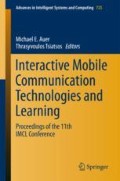Abstract
Time is a complex concept to grasp for elementary students and time related competencies take years to fully develop. In this article, we present and evaluate an instructional approach for learning to read and write time through embodied interactions with tangible clocks. The instructional approach consists of four “time learning stations” that may facilitate groups of 12 students (separated in teams of 3) to learn about time. The “time stations” include (a) a game with a big tangible 3D clock, (b) a game with a miniature tangible clock, (c) two notebooks with learning games about time, (d) a set of typical hand-written worksheets about time. Each team explores each station for 10 min and afterwards students move in a circular pattern to the next station. In order to evaluate the instructional approach, 84 students participated in a pilot study forming 7 groups of 12 students that used the time stations for approximately 45 min. Focus groups were conducted after each round of runs. Students supported that the whole setting greatly helped them to get acquainted with time and clock reading. Students underlined that the big 3D tangible clock was the most useful and entertaining activity and pinpointed that the specific interface was more engaging, the interactions were more kinesthetic and unexpected while the learning representation was significantly different from any other that they have used in the past.
Access this chapter
Tax calculation will be finalised at checkout
Purchases are for personal use only
References
Block, R.A.: Experiencing and remembering time: affordances, context, and cognition. In: Levin, I., Zakay, D. (eds.) Time and Human Cognition: A Life-Span Perspective, pp. 333–363. Amsterdam (1989). http://doi.org/10.1016/S0166-4115(08)61046-8
Piaget, J.: The Child’s Conception of Time. Ballantine, New York (1969). Original Work Published 1946a (Trans. by, A.J. Pomerans)
Levin, I., Gilat, I.: A developmental analysis of early time concepts: the equivalence and additivity of the effect of interfering cues on duration comparisons of young children. Child Dev. 78–83 (1983)
Dawson, I.: Time for chronology? Ideas for developing chronological understanding. Teach. Hist. 14 (2004)
Hoodless, P.A.: An investigation into children’s developing awareness of time and chronology in story. J. Curric. Stud. 34(2), 173–200 (2002)
Burny, E., Valcke, M., Desoete, A.: Towards an agenda for studying learning and instruction focusing on time-related competences in children. Educ. Stud. 35(5), 481–492 (2009). https://doi.org/10.1080/03055690902879093
Foreman, N., Boyd-Davis, S., Moar, M., Korallo, L., Chappell, E.: Can virtual environments enhance the learning of historical chronology? Instr. Sci. 36(2), 155–173 (2008)
Slavin, R.E., Lake, C.: Effective programs in elementary mathematics: a best-evidence synthesis. Rev. Educ. Res. 78(3), 427–515 (2008)
Wang, F., Xie, H., Wang, Y., Hao, Y., An, J.: Using touchscreen tablets to help young children learn to tell time. Front. Psychol. 7 (2016)
Barsalou, L.W.: Grounded cognition. Annu. Rev. Psychol. 59, 617–645 (2008)
Antle, A.N.: The CTI framework: informing the design of tangible systems for children. In: Proceedings of the 1st International Conference on Tangible and Embedded Interaction, pp. 195–202. ACM (2007)
Malinverni, L., Pares, N.: Learning of abstract concepts through full-body interaction: a systematic review. Educ. Technol. Soc. 17(4), 100–116 (2014). https://doi.org/10.2307/jeductechsoci.17.4.100
Lindgren, R., Tscholl, M., Wang, S., Johnson, E.: Enhancing learning and engagement through embodied interaction within a mixed reality simulation. Comput. Educ. 95, 174–187 (2016)
Dede, C.: Immersive interfaces for engagement and learning. Science 323(5910), 66–69 (2009)
Manches, A., O’Malley, C., Benford, S.: The role of physical representations in solving number problems: a comparison of young children’s use of physical and virtual materials. Comput. Educ. 54(3), 622–640 (2010)
Cramer, E.S., Antle, A.N.: Button matrix: how tangible interfaces can structure physical experiences for learning. In: Proceedings of the Ninth International Conference on Tangible, Embedded, and Embodied Interaction, pp. 301–304. ACM, January 2015
Lee, S.A., Chung, A.M., Cira, N., Riedel-Kruse, I.H.: Tangible interactive microbiology for informal science education. In: Proceedings of the Ninth International Conference on Tangible, Embedded, and Embodied Interaction, pp. 273–280. ACM, January 2015
Zacharia, Z.C., Olympiou, G.: Physical versus virtual manipulative experimentation in physics learning. Learn. Instr. 21(3), 317–331 (2011)
Sloutsky, V.M., Kaminski, J.A., Heckler, A.F.: The advantage of simple symbols for learning and transfer. Psychon. Bull. Rev. 12(3), 508–513 (2005)
Carbonneau, K.J., Marley, S.C., Selig, J.P.: A meta-analysis of the efficacy of teaching mathematics with concrete manipulatives. J. Educ. Psychol. 105(2), 380 (2013)
Stull, A.T., Barrett, T., Hegarty, M.: Usability of concrete and virtual models in chemistry instruction. Comput. Hum. Behav. 29(6), 2546–2556 (2013)
Goodman, S.G., Seymour, T.L., Anderson, B.R.: Achieving the performance benefits of hands-on experience when using digital devices: a representational approach. Comput. Hum. Behav. 59, 58–66 (2016)
Steinberg, G.: Natural user interfaces. In: ACM SIGCHI Conference on Human Factors in Computing Systems. ACM (2012). https://www.cs.auckland.ac.nz/compsci705s1c/exams/SeminarReports/natural_user_interfaces_gste097.pdf
Mpiladeri, M., Palaigeorgiou, G., Lemonidis, C.: Fractangi: a tangible learning environment for learning about fractions with an interactive number line. Int. Assoc. Dev. Inf. Soc. (2016)
Author information
Authors and Affiliations
Corresponding author
Editor information
Editors and Affiliations
Rights and permissions
Copyright information
© 2018 Springer International Publishing AG, a part of Springer Nature
About this paper
Cite this paper
Palaigeorgiou, G., Tsapkini, D., Bratitsis, T., Xefteris, S. (2018). Embodied Learning About Time with Tangible Clocks. In: Auer, M., Tsiatsos, T. (eds) Interactive Mobile Communication Technologies and Learning. IMCL 2017. Advances in Intelligent Systems and Computing, vol 725. Springer, Cham. https://doi.org/10.1007/978-3-319-75175-7_47
Download citation
DOI: https://doi.org/10.1007/978-3-319-75175-7_47
Published:
Publisher Name: Springer, Cham
Print ISBN: 978-3-319-75174-0
Online ISBN: 978-3-319-75175-7
eBook Packages: EngineeringEngineering (R0)

